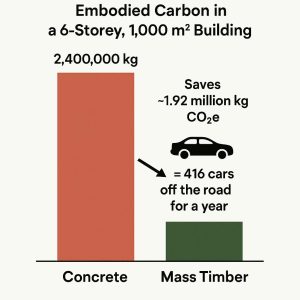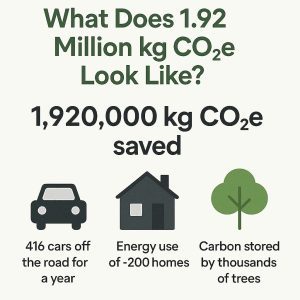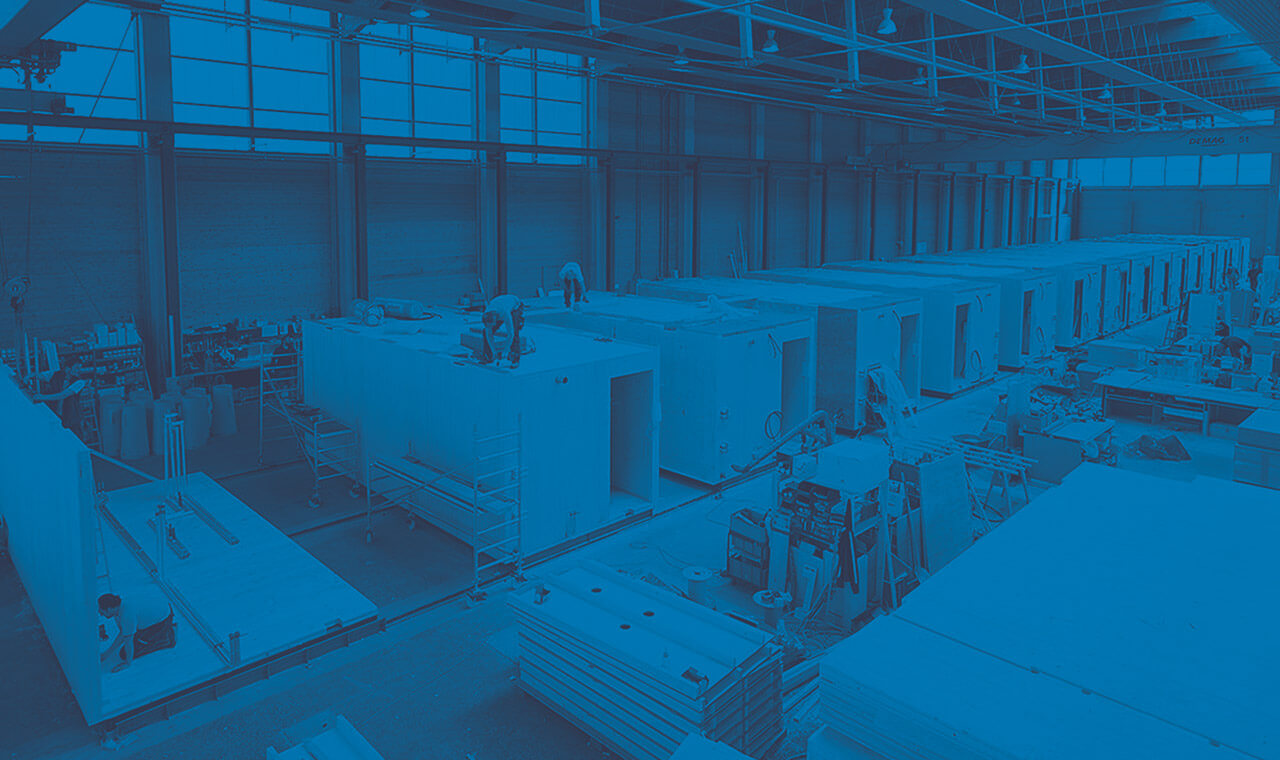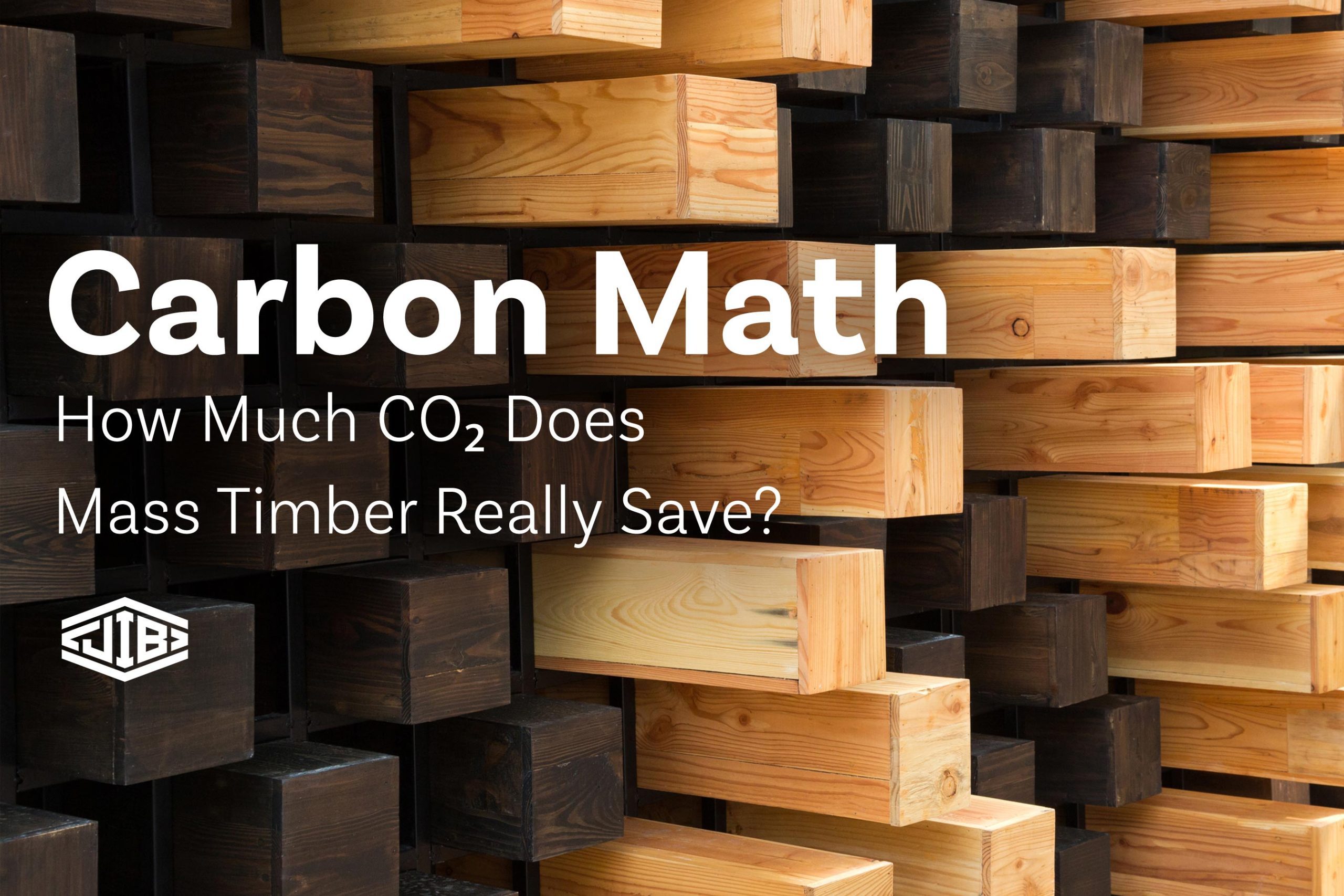Everyone’s talking about mass timber as the building material of the future. It’s strong, beautiful, fast to build, and it’s often praised as a climate hero.
But just how much carbon does mass timber really save compared to traditional materials like concrete and steel?
Welcome to Carbon Math—where we translate complex sustainability data into simple terms you can actually visualize (and explain to your clients, colleagues, or friends).
Let’s do the math.

Timber vs. Concrete: A Real Example*
Let’s imagine we’re building a mid-rise commercial building with a 1,000 m² (10,764 ft²) floorplate and 6 storeys tall.
Using Concrete Structure:
- Average embodied carbon for concrete structural systems = 300–500 kg CO₂e/m²
→ For our building:
1,000 m² × 6 floors × 400 kg CO₂e/m² = 2,400,000 kg CO₂e
Using Mass Timber Structure:
- Average embodied carbon for mass timber structural systems = 60–100 kg CO₂e/m²
→ For our building:
1,000 m² × 6 floors × 80 kg CO₂e/m² = 480,000 kg CO₂e
Total Carbon Savings:
2,400,000 kg – 480,000 kg = 1,920,000 kg CO₂e saved

What Does That Mean in Real Life?
OK—that’s a big number. But what does 1,920,000 kg of CO₂e actually look like?
✅ That’s equal to:
- 416 passenger cars driven for an entire year
- 4.75 million miles driven by an average gasoline car
- Around 200 average Canadian homes’ annual energy use
✅ Or put another way:
One mid-rise timber building → same impact as taking an entire dealership’s worth of cars off the road for a year.

Bonus: Timber Stores Carbon Too
Beyond reducing emissions, timber stores carbon from the trees it came from. Roughly:
- Every m³ of wood stores ~0.9 tonnes of CO₂
So in our example building:
- Approximate volume of timber used = 1,000 m³ → stores ~900 tonnes of CO₂
So not only are you saving carbon—you’re locking some away inside your building.
Why This Matters
Buildings account for nearly 40% of global CO₂ emissions. Switching structural materials from concrete to mass timber can:
✅ Lower embodied carbon
✅ Reduce the need for energy-intensive cement
✅ Create buildings that act as carbon sinks
It’s not just green marketing—it’s real numbers making real impact.
Simple Rule of Thumb
Here’s an easy takeaway:
Switching from concrete to mass timber often cuts embodied carbon by 60–80%.
Want to Do Your Own Carbon Math?
Curious how much carbon your next project could save with mass timber? Let’s crunch the numbers together.
*Context and Caveats
- Sourcing and Transportation: The environmental benefits of mass timber are highly dependent on. sustainable forestry practices. If the timber is sourced from poorly managed forests or has to be transported long distances, its overall carbon savings can be reduced.
- End-of-Life: The carbon stored in mass timber remains sequestered as long as the wood is not burned or left to decompose in a landfill. Studies highlight the importance of “circular economy” practices, such as reusing or recycling the timber at the end of a building’s life, to maintain the carbon storage benefit.
- Whole-Building Impact: While mass timber is a more sustainable structural material, a building’s overall carbon footprint also includes other elements like insulation, finishes, and operational energy use, which are often a much larger portion of a building’s total lifetime emissions
At Jib, we specialize in translating sustainability into real-world insights.
Wondering how storytelling and smart marketing can advance offsite construction, mass timber, and sustainability in North America?
Whether you’re in AEC, sustainability, or shaping the built environment, we’d love to connect. Let’s talk – or explore BuildBetter.Marketing.
Structure needs story. Jib delivers.











